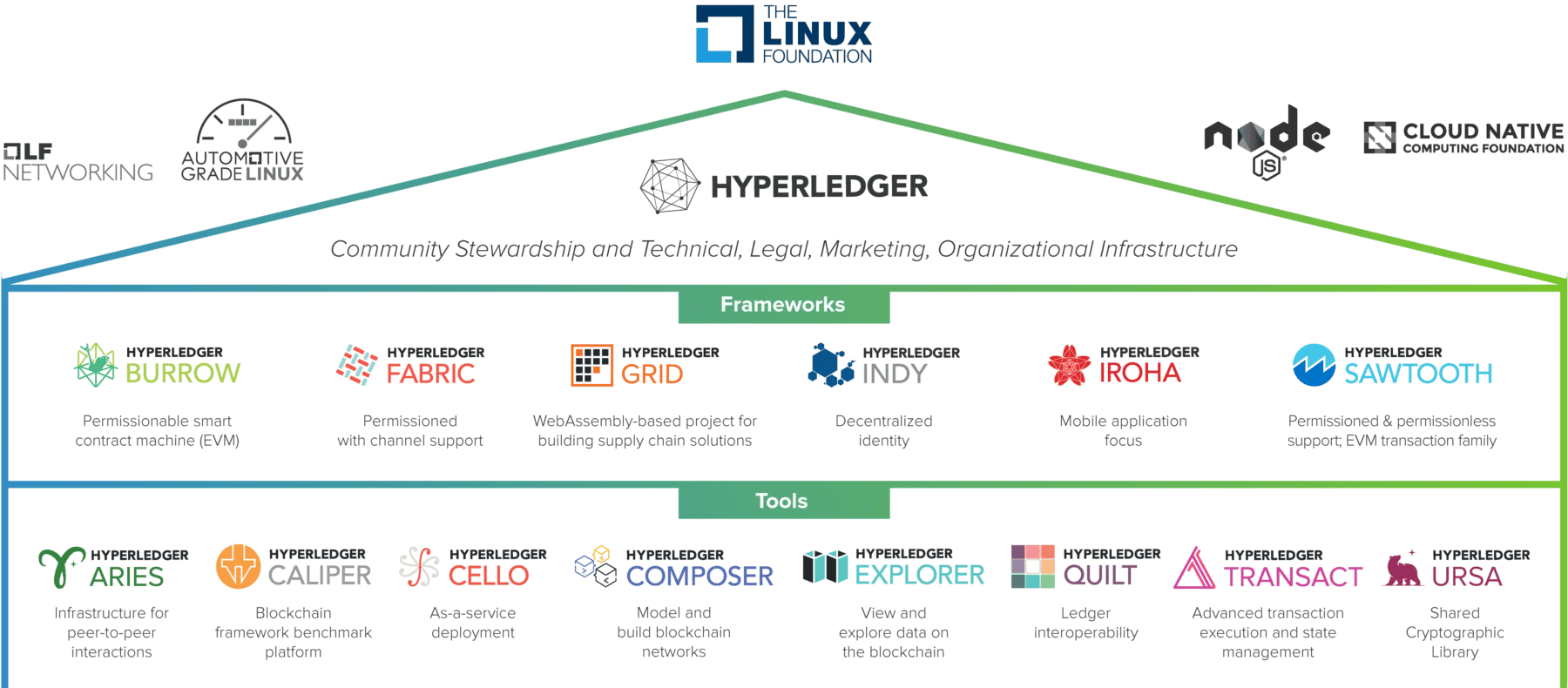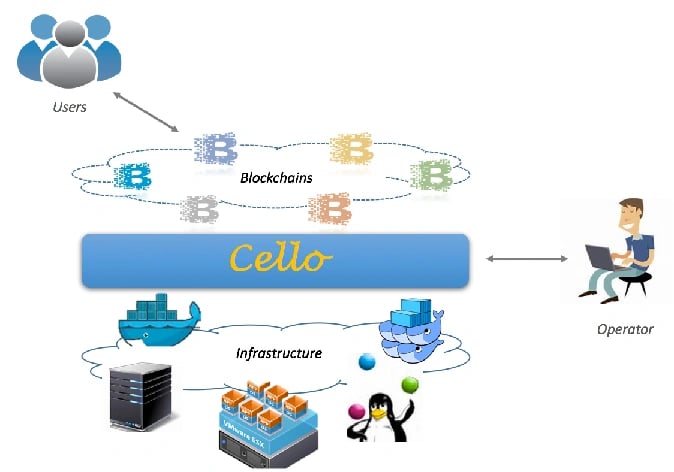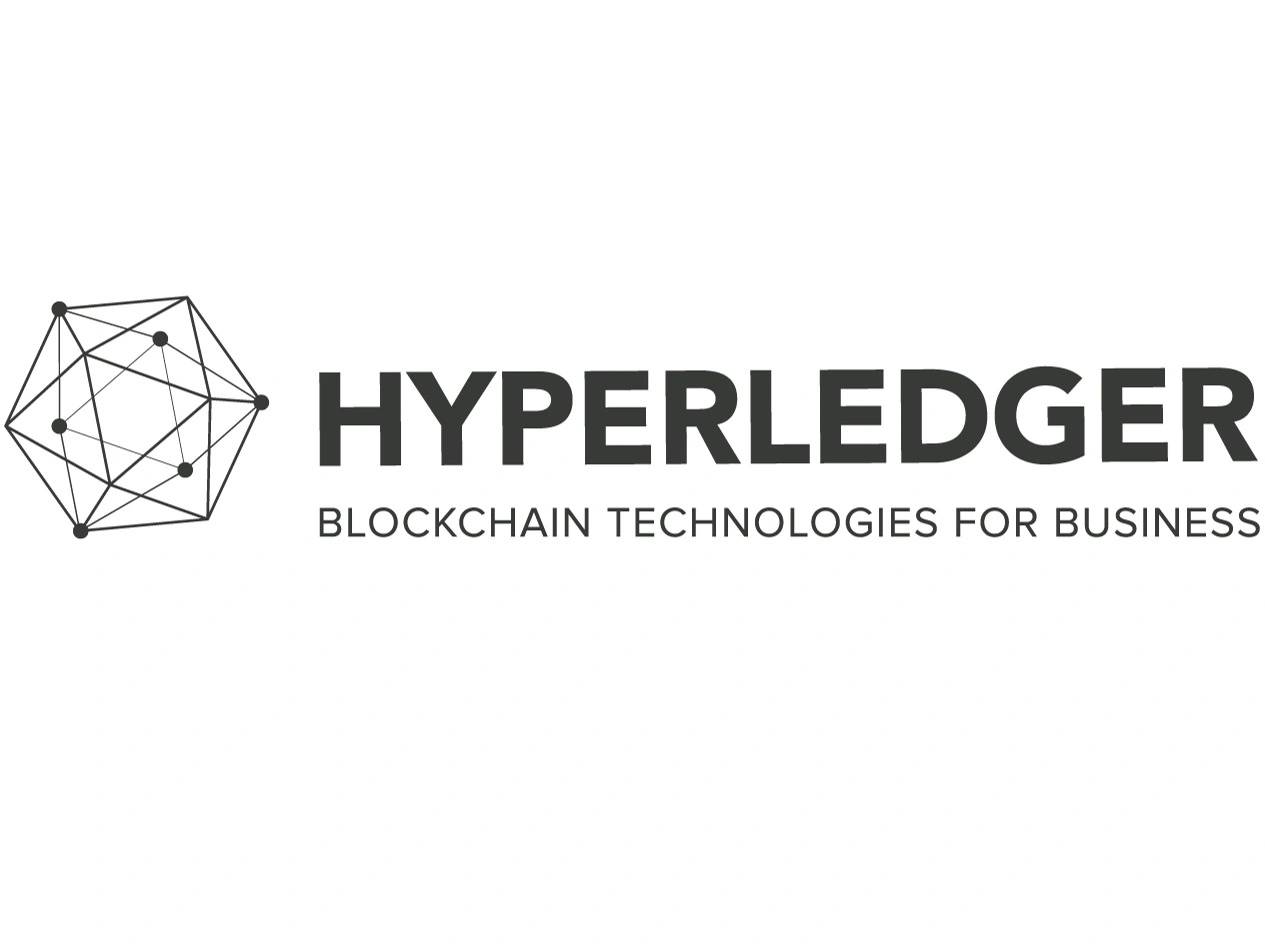Subscribe to wiki
Share wiki
Bookmark
Hyperledger
The Agent Tokenization Platform (ATP):Build autonomous agents with the Agent Development Kit (ADK)
Hyperledger
Hyperledger is a collection of open-source projects created to support the development of blockchain-based distributed ledgers. It aims to create the needed frameworks, standards, tools and libraries to build blockchains and related applications.[1]
Overview

Hyperledger is an umbrella project of open-source blockchains and blockchain-related tools started by the Linux Foundation in 2015 to support the collaborative development of blockchain-based distributed ledgers. Initially, the Hyperledger Foundation only included two main projects - Hyperledger Fabric, a codebase combining work by Digital Asset, libconsensus from Blockstream and OpenBlockchain from IBM; and Hyperledger Sawtooth, developed at Intel’s incubation group. At the moment, however, the Hyperledger Foundation is the fastest developing project Linux has launched. [5]
Through a rich collection of different stable frameworks, tools, and libraries for enterprise-grade blockchain deployments, Hyperledger aims to push the mass enterprise adoption of blockchain technology.
While cryptocurrencies like Bitcoin and Ethereum rely on permissionless blockchains, the Hyperledger Foundation focuses on creating permissioned enterprise blockchains. What this means is that the blockchains are operated in a private network where participants have the intrinsic benefit of complying with the consensus rules.
With the launch of Hyperledger, the Linux Foundation set out five main goals for the project. One of the biggest missions of the project is to create an intuitive, blockchain-based ecosystem for enterprises to communicate internally and with each other. Another important goal for the Hyperledger Foundation is to push educational materials and events in order to showcase the numerous market opportunities for blockchain technology. Because of the innate characteristics of blockchains, the Hyperledger Foundation also aims to create a neutral, open, and community-driven infrastructure for businesses. Last but not least, the foundation is striving to promote and build a strong community spirit to help with the further development of blockchain technology in the enterprise field.
The Hyperledger Foundation has successfully developed numerous real-life use cases and applications for blockchain technology throughout its work and partnerships. Spanning from financial services through supply chain management to healthcare, one of the foundation’s main goals is to introduce blockchain technology to as many industries as possible.
With enterprise partners like IBM, Walmart, Honeywell, Fujitsu, and Intel, the Hyperledger Foundation is one of the best-recognized blockchain ecosystems globally. As interest in blockchain technology rises exponentially, the foundation is expanding its reach to new industries and various new use cases.[2]
History
The Linux Foundation announced the creation of the Hyperledger Project in 2015, one year prior to its release. Brian Behlendorf was appointed to the position of executive director. Behlendorf stated that the Hyperledger project would never build its own cryptocurrency.
In 2016, the project also started to accept proposals for the incubation of codebases and other core element technologies. Two of the initial blockchain framework codebases accepted were Hyperledger Fabric and libconsensus. Later, Intel's distributed ledger, Sawtooth, was incubated.
In 2018, the production-ready Sawtooth 1.0 was added.
In 2019, a long-term-support version of Hyperledger Fabric was announced.
In October 2021, Behlendorf passed the executive director position to Daniela Barbosa. That same month, Hyperledger was rebranded to The Hyperledger Foundation to draw a "clearer line between Hyperledger as an organization and individual Hyperledger projects," according to a blog post from the organization announcing the change.
Major Frameworks
Two of the most notable Hyperledger frameworks include Hyperledger Fabric and Sawtooth.
Hyperledger Fabric
This is one of the most popular projects in Hyperledger. It is an open-source enterprise-grade permissioned distributed ledger technology (DLT) platform, designed for use in enterprise contexts, that delivers some key differentiating capabilities over other popular distributed ledger or blockchain platforms. Hyperledger Fabric was made in cooperation with IBM and Digital Asset. It provides a modular architecture that defines roles between nodes, execution of smart contracts, and configurable consensus services. Features of Fabric include the use of smart contracts, as well as pluggable Hyperledger Fabric consensus protocols. Fabric also supports different programming languages through the installation of modules. Hyperledger Fabric is used with integration projects that need a distributed ledger.
Fabric has a highly modular and configurable architecture, enabling innovation, versatility and optimization for a broad range of industry use cases including banking, finance, insurance, healthcare, human resources, supply chain, and even digital music delivery.
Fabric is the first distributed ledger platform to support smart contracts authored in general-purpose programming languages such as Java, Go, and Node.js, rather than constrained domain-specific languages (DSL). This means that most enterprises already have the skill set needed to develop smart contracts, and no additional training to learn a new language or DSL is needed.
The Fabric platform is also permissioned, meaning that, unlike with a public permissionless network, the participants are known to each other, rather than anonymous and therefore fully untrusted. This means that while the participants may not fully trust one another (they may, for example, be competitors in the same industry), a network can be operated under a governance model that is built off of what trust does exist between participants, such as a legal agreement or framework for handling disputes.
Fabric can leverage consensus protocols that do not require a native cryptocurrency to incent costly mining or to fuel smart contract execution. Avoidance of a cryptocurrency reduces some significant risk/attack vectors, and the absence of cryptographic mining operations means that the platform can be deployed with roughly the same operational cost as any other distributed system.
The combination of these differentiating design features makes Fabric one of the better-performing platforms available today both in terms of transaction processing and transaction confirmation latency, and it enables privacy and confidentiality of transactions and the smart contracts (what Fabric calls “chaincode”) that implement them.
The differentiating capabilities of Fabric make it a highly scalable system for permissioned blockchains[4] supporting flexible trust assumptions that enable the platform to support a wide range of industry use cases ranging from government, to finance, to supply-chain logistics, to healthcare and so much more.
Hyperledger Fabric is the most active of the Hyperledger projects. The community building around the platform is growing steadily, and the innovation delivered with each successive release far out-paces any of the other enterprise blockchain platforms.[3]
Hyperledger Sawtooth
Hyperledger Sawtooth is an enterprise blockchain platform for building distributed ledger applications and networks. The design philosophy targets keeping ledgers distributed and making smart contracts safe, particularly for enterprise use. This is a permissioned modular blockchain platform contributed by Intel.
Sawtooth simplifies blockchain application development by separating the core system from the application domain. Application developers can specify the business rules appropriate for their application, using the language of their choice, without needing to know the underlying design of the core system.
Sawtooth is built to solve the challenges of permissioned (private) networks. Clusters of Sawtooth nodes can be easily deployed with separate permissions. There is no centralized service that could potentially leak transaction patterns or other confidential information. The blockchain stores the settings that specify the permissions, such as roles and identities so that all participants in the network can access this information.[7]
Hyperledger Sawtooth provides an extremely modular and flexible platform for implementing transaction-based updates to shared states between untrusted parties coordinated by consensus algorithms and it can help businesses that have a difficult time working with blockchain technology.
Sawtooth features include Dynamic Consensus, Transaction Families, Proof of Elapsed Time (a type of consensus algorithm), Parallel Transaction Execution (which allows the creation of individual chains), and Private Transactions. It also supports Ethereum smart contracts. Software development kits (SDKs) for Python, Go, JavaScript, Rust, Java, and C++ are also available. Sawtooth is meant for businesses that need a permissioned and modular blockchain platform.[6]
Other Hyperledger Tools and Projects
Hyperledger Fabric and Sawtooth are not the only two projects Hyperledger has. Hyperledger offers multiple projects and tools currently active or under incubation, meaning they require certain exit criteria before being declared active and production-ready. Some of these projects include:
- Hyperledger Iroha. A blockchain framework is used to integrate with existing networks. Hyperledger Iroha is designed to be simple and easy to incorporate into infrastructural or IoT projects requiring distributed ledger technology. Hyperledger Iroha features simple construction, modular, domain-driven C++ design, emphasis on client application development, and a new, crash fault tolerant consensus algorithm, called YAC. Iroha has a modular design, control-based access, access to many libraries, as well as asset and identity management. It is used in fields such as financial services, healthcare, and education.[9]
-
Hyperledger Indy. A framework made for decentralized identities. It comes with components, tool sets, libraries, and reusable components for providing digital identities rooted in blockchains or other distributed ledgers so that they are interoperable across administrative domains, applications, and any other silo. It also includes self-sovereignty, which securely stores all identity-based documentation.
Key Characteristics:
- Distributed ledger purpose-built for decentralized identity
- Correlation-resistant by design
- DIDs (Decentralized Identifiers) that are globally unique and resolvable (via a ledger) without requiring any centralized resolution authority
- Pairwise Identifiers create secure, 1:1 relationships between any two entities
- Verifiable Claims are interoperable formats for exchange of digital identity attributes and relationships currently in the standardization pipeline at the W3C
- Zero Knowledge Proofs which prove that some or all of the data in a set of Claims is true without revealing any additional information, including the identity of the Prover.[8]
- Hyperledger Besu. An open-source Ethereum codebase that can run on private permissioned platforms or the Ethereum public network. Hyperledger Besu is an Ethereum client designed to be enterprise-friendly for both public and private permissioned network use cases, with an extractable Ethereum Virtual Machine (EVM) implementation. It can also be run on test networks such as Sepolia and Görli. Hyperledger Besu includes several consensus algorithms including Proof of Stake, Proof of Work, and Proof of Authority (IBFT 2.0, QBFT, and Clique). Its comprehensive permissioning schemes are designed specifically for use in a consortium environment. It also features user-facing APIs and monitoring.[10]
- Hyperledger Explorer. A dashboard utility tool that allows a user to monitor, search and maintain the blockchain and related data. With it, an organization can check nodes, blocks, transactions and smart contracts. It also allows users to make code changes. Hyperledger Explorer is a user-friendly Web application tool used to view, invoke, deploy or query blocks, transactions and associated data, network information (name, status, list of nodes), chain codes and transaction families, as well as any other relevant information stored in the ledger.[11] There are 2 options to get Explorer started - Quick start using Docker and Quick start using codebase - with the software dependencies required for each option. [12]
- Hyperledger Cello. A blockchain-as-a-service toolkit used to create, terminate and manage blockchain services. Hyperledger Cello aims to serve as the operational dashboard for Blockchain, which reduces the effort required for creating, managing and using blockchains. Besides, it can also be used to facilitate creating Blockchain as a Service. Cello provides an operational console for managing blockchain’s efficiently and running on top of various infrastructures, e.g., baremetal, virtual machine, and various container platforms.[13]
Using Cello, everyone can easily:
- Build up a Blockchain as a Service (BaaS) platform quickly from scratch.
- Provision customizable Blockchains instantly, e.g., a Hyperledger fabric network v1.0.
- Maintain a pool of running blockchain networks on top of baremetals, Virtual Clouds (e.g., virtual machines, vsphere Clouds), Container clusters (e.g., Docker, Swarm, Kubernetes).
- Check the system status, adjust the chain numbers, scale resources... through dashboards.[14]

- Hyperledger Burrow. A permissioned Ethereum smart contract blockchain node. This handles transactions and smart contract code execution on the EVM. Hyperledger Burrow was moved to EOL (End of Life) status by the TSC (Technical Oversight Committee) on 12 May 2022.[15]
- Hyperledger Bevel. Hyperledger Bevel is an accelerator that helps developers rapidly set-up and deploy secure, scalable and production ready DLT network(s) that also allows new organizations to be easily onboarded on the network. Bevel accelerates DLT network deployment and lets developers focus on building blockchain applications without having to waste precious time standing up the environment or worrying whether the network will scale and meet production requirements. Bevel facilitates a safe and secure way of deploying and operating different DLT platforms.[16]
- Hyperledger Firefly. An open-source software stack of middleware for Web3 applications. Hyperledger FireFly is the first open source Supernode: a complete stack for enterprises to build and scale secure Web3 applications. The FireFly API for digital assets, data flows, and blockchain transactions makes it radically faster to build production-ready apps on popular chains and protocols.[17]
The easiest way to understand a FireFly Supernode is to think of it like a toolbox. Connecting existing apps and/or back office systems to the toolbox and within it, there are two different sets of tools. One set of tools helps you connect to the Web3 world that already exists, and the other set allows you to build new decentralized applications quickly with security and scalability.[\[18\]](#cite-id-gf80z0c4rpo)
-
Hyperledger Cacti. Created by the merger of two systems (architectures as well as code bases), Hyperledger Cacti is a multi-faceted interoperability platform connecting and running transactions across multiple heterogeneous ledgers that draws on the cutting-edge technical features of Hyperledger Cactus and Weaver, a Hyperledger Lab. [19]
-
Hyperledger Solang. A Solidity compiler that enables smart contract portability. The idea for Solang arose from early work on Hyperledger Burrow. Since the existing Solidity compiler is specific for Ethereum, there was no interest in supporting features for Hyperledger Burrow. From that problem, a portable Solidity compiler that could support many blockchains was born, making it possible to have different features depending on which blockchain is being targeted.
The Solidity programming language is the most popular language for smart contracts, and there is clear interest from many blockchains to have support for it. Although some blockchains emulate an EVM environment to maintain compatibility with Solidity built with Solc, they cannot access missing features from Ethereum that an emulated EVM environment cannot provide, such as cryptographic functions, like blake2, zero-knowledge proof and the ability to call native contracts or be called by them. Hyperledger Solang offers the ability to compile Solidity to native execution environments other than the EVM, allowing the language many new possibilities and innovations. Currently, Hyperledger Solang supports Solana and Polkadot (Substrate)[20]
-
Hyperledger Aries. Hyperledger Aries provides a shared, reusable, interoperable tool kit designed for initiatives and solutions focused on creating, transmitting and storing verifiable digital credentials and decentralized key management. It is infrastructure for blockchain-rooted, peer-to-peer interactions. This project consumes the cryptographic support provided by Hyperledger Ursa, to provide secure secret management and decentralized key management functionality.[21]
-
Hyperledger Anoncreds. Hyperledger AnonCreds – short for “Anonymous Credentials”
- is the most commonly used ledger-agnostic Verifiable Credential (VC) format in the world that has been in use since 2017, initially as part of the Hyperledger Indy open source project and now in the Hyperledger AnonCreds project. Ledger agnostic and with a formal open specification, AnonCreds is a VC format that adds important privacy-protecting ZKP (zero-knowledge proof) capabilities to the core VC assurances.[22][23]
- Hyperledger Caliper. A blockchain benchmark tool. Caliper is used to evaluate the performance of blockchain implementations. However, it doesn't come with predefined standards because blockchain implementations may all require different sets of standards. It allows users to measure the performance of a blockchain implementation with a set of predefined use cases. Hyperledger Caliper will produce reports containing a number of performance indicators to serve as a reference when using the following blockchain solutions: Hyperledger Besu, Hyperledger Burrow, Ethereum, Hyperledger Fabric, FISCO BCOS, Hyperledger Iroha and Hyperledger Sawtooth.[24]
As of 2022, Hyperledger moved four projects to end-of-life (EOL) status by the TSC (Technical Oversight Committee): Avalon, Burrow, Explorer and Quilt.
See something wrong?
The Agent Tokenization Platform (ATP):Build autonomous agents with the Agent Development Kit (ADK)
